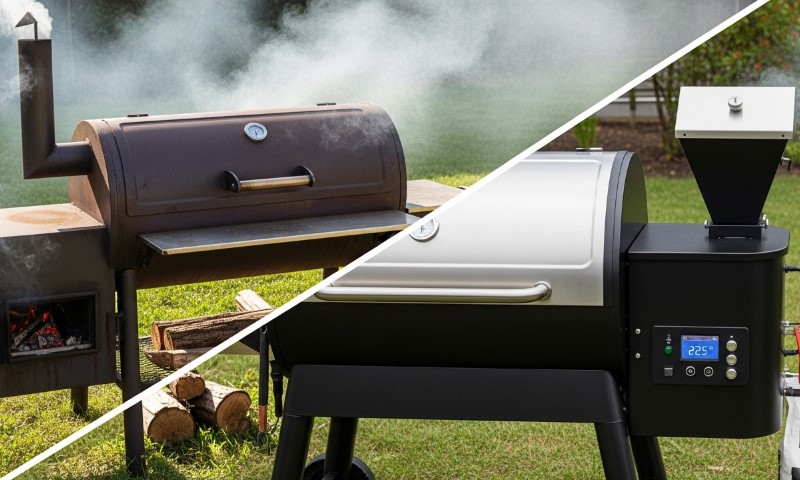If you’re stuck between the romance of tending a live fire and the ease of set-and-forget barbecue, you’re not alone.
Offset smokers and pellet grills both make extraordinary barbecue, yet they go about it in very different ways. The key is matching the tool to your cooking style, patience, and flavor goals.
Here’s a look at flavor, consistency, learning curve, cost of ownership, maintenance, and safety so you can pick the right pit with confidence.
Quick Answer
Choose an offset smoker if you want bold, wood-forward flavor, enjoy fire-tending, and can invest time in learning fuel management.
Expect a more hands-on experience, a steeper learning curve, and the potential for the deepest smoke profile when you run the pit well.
Choose a pellet grill if you want convenience, tight temperature control, and consistent results with minimal effort.
Pellets deliver cleaner, lighter smoke, Wi-Fi control on many models, and true set-and-forget cooking. The tradeoff is a milder smoke profile and reliance on electricity.
What Each One Is and How It Works
Let’s take a look at how an offset smoker and a pellet grill operate.
Offset Smoker in a Nutshell
An offset smoker places a firebox to the side of a horizontal cooking chamber. Heat and clean blue smoke flow from the firebox through the chamber and out the stack.
You regulate temperature by controlling fire size and airflow. Good offsets are built from thick steel for stability and even heat.
Some feature reverse-flow designs to even out hot spots; others rely on tuning plates or natural flow.
Pellet Grill in a Nutshell
A pellet grill burns compressed hardwood pellets that are fed by an auger from a hopper into a small fire pot.
A digital controller and fan keep temperatures steady. Many models include Wi-Fi apps, meat probes, and advanced PID controllers.
Pellets are the fuel, while a small amount of electricity runs the auger, fan, and igniter.
How Do Results Actually Taste?
Smoke, fire, and fuel all leave their mark on meat. Before getting into specs and features, it helps to know how each cooker shapes the taste on your plate.
Offset Smoker Flavor
Offset smokers run on a real wood fire. When managed well, they produce a clean, thin smoke that penetrates deeply and gives a classic Central Texas style profile.
Because the fire is live, each cook feels like a craft project: brisket, pork shoulder, beef ribs all take on a nuanced, wood-rich crust and smoke ring.
Pellet Grill Flavor
Pellet grills produce a lighter smoke that many describe as subtle and consistent. At higher temperatures the smoke becomes faint.
You can make excellent barbecue, but the profile is more delicate than a well-run offset.
Some brands offer “smoke boost” settings or specialized pellets (mesquite, hickory, blends) to bump up flavor, but it’s still a cleaner, milder profile compared to a true wood fire.
Temperature Control, Consistency, and Learning Curve
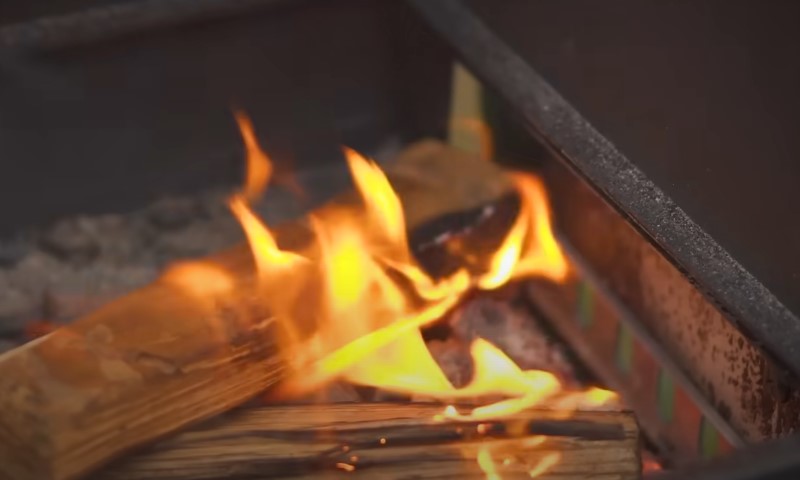
Keeping steady heat separates great barbecue from the rest. Here’s how each cooker handles temperature, consistency, and the learning curve behind it.
Offsets Require Skill and Attention
Offsets demand tending a fire every 15 to 45 minutes depending on pit size, weather, and wood. You’ll learn how to build a coal bed, size your splits, and adjust intake and stack to keep 225 to 300°F stable.
Thick steel helps a lot. Cheap leaky offsets are harder to run and can frustrate new cooks. Once you master it, though, you can run a long cook with steady temps and impressive results.
Pellet Grills Make It Easy
Pellet grills excel at consistent temperature. PID controllers and fans hold setpoints with little effort. Many models run reliably between about 180 and 450°F, sometimes higher.
The minimum temp on many units is closer to 180 to 200°F. You fill the hopper, set the temp, insert your probes, and focus on other tasks.
For beginners or those cooking multiple weeknight meals, this is a game-changer.
Fuel Use, Operating Cost, and Power Needs
Fuel shapes your cooking rhythm, your budget, and even where you can set up. Here’s how both options stack up when it comes to burn rates, cost per cook, and the power needed to keep things running.
Pellet Grill Fuel Data
- Pellet burn rate: Commonly 1 to 3 lb per hour depending on temperature and model. A 20 lb bag lasts roughly 6 to 20 hours.
- Pellet pricing: In 2025, big-box pricing often sits around 20 to 25 USD per 20–30 lb bag for major brands like Traeger, with lower prices from value brands or bulk deals.
- Electricity: Startup often draws 300 to 600 watts for several minutes, then 25 to 50 watts to run the auger, fan, and controller. That’s a minimal cost on most power bills but matters for off-grid cooks.
Offset Smoker Fuel Data
- Wood consumption: Depends on pit size and steel thickness, but you’ll burn a steady stream of split hardwood after building a coal bed. Many backyard offsets sip smaller splits every 20 to 45 minutes during a typical 6 to 12 hour cook. Efficient reverse-flow or thick-steel pits stretch those intervals.
- Firewood pricing: In the U.S., a full cord of seasoned hardwood often ranges 150 to 500 USD, with many markets near 300 USD. Your cost per cook depends on the quality of your pit and local wood prices.
Capacity, Versatility, and What You Can Cook
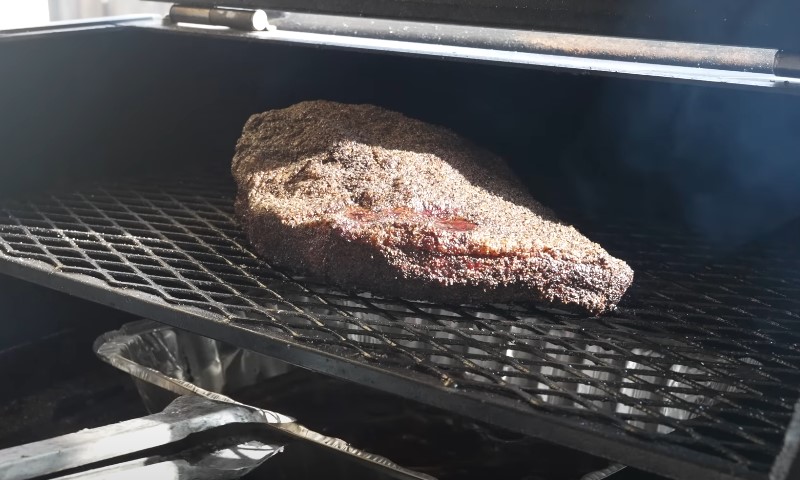
Big cuts or quick weeknight meals? The right pit can do both if it’s built for it. Here’s how capacity and versatility shape your options.
Offset Smoker Capacity
Offsets shine on large cuts like brisket, pork shoulder, beef ribs, and multiple racks of ribs thanks to roomy grates and smooth airflow.
With a hot firebox plate or an added grill grate, you can simmer beans or sear a steak over the box while the meat smokes. Owners commonly add small utility features to the firebox for sauce pots and sides.
Pellet Grill Versatility
Pellet grills are true multi-cookers. They smoke, roast, bake pies and bread, and often reach 450 to 500°F for hot roasting.
Direct high-heat searing is model-dependent; some include sear plates or add-on grates. But many still prefer a dedicated sear tool for true steakhouse crust. Independent testing and editor reviews reinforce that versatility.
Build Quality and Budget Reality
Food gear isn’t just about looks. Let’s weigh how construction, materials, and price shape your day-to-day barbecue experience.
Offsets
The market splits between Cheapo Offset Smokers (COS) that are thin, leaky, and hard to control, and Expensive Offset Smokers (EOS) that are heavy, tight, and stable.
That difference dramatically affects your experience. If you go offset, save for thicker steel and good seals. It pays back in ease of use and fuel efficiency.
Pellet Grills
Quality varies in controller accuracy, insulation, and fit. Better units hold temp in cold or windy weather and reduce pellet consumption. Reputable testers maintain running lists and ratings of current models.
Cleaning and Maintenance
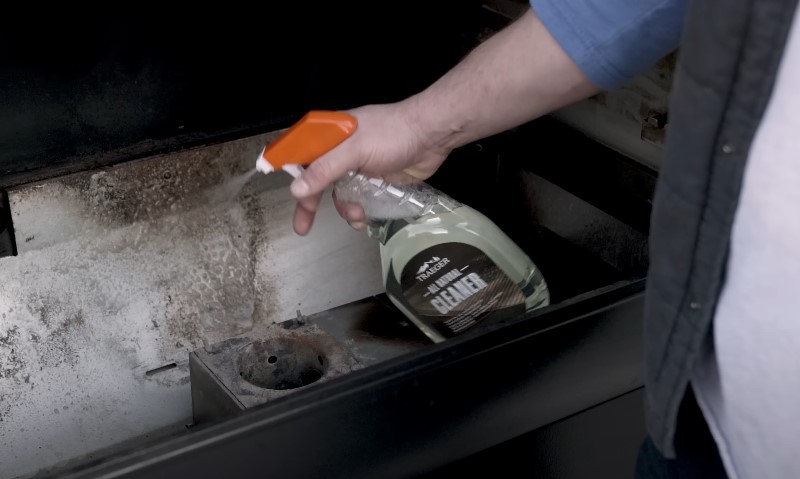
Keeping your pit in top shape isn’t complicated, but it does matter. A little routine care after each cook keeps performance steady, flavors clean, and your investment lasting longer.
Offset Maintenance
Ash cleanup is manual, and rust prevention matters. Keep surfaces oiled, clean out ash after each cook, and store the pit under cover. Thicker steel resists heat warping and holds up better over time.
Pellet Grill Maintenance
Empty ash from the fire pot every few cooks, vacuum the chamber as needed, and keep pellets dry to avoid auger jams.
Store pellets in sealed containers to prevent swelling. Many manufacturers outline easy maintenance schedules.
Food Safety and Temperature Targets
No matter what you cook on, the food needs to hit safe internal temperatures. The USDA’s Food Safety and Inspection Service provides clear guidance:
| Food Type | Target Internal Temp | Rest Time |
| Beef, pork, lamb roasts and steaks | 145°F | 3 minutes rest |
| Ground meats | 160°F | Not applicable |
| Poultry | 165°F | Not applicable |
Keep smoker temperature in the typical 225 to 300°F range for hot smoking, and use a food thermometer to verify doneness.
Cost-of-Cook Examples
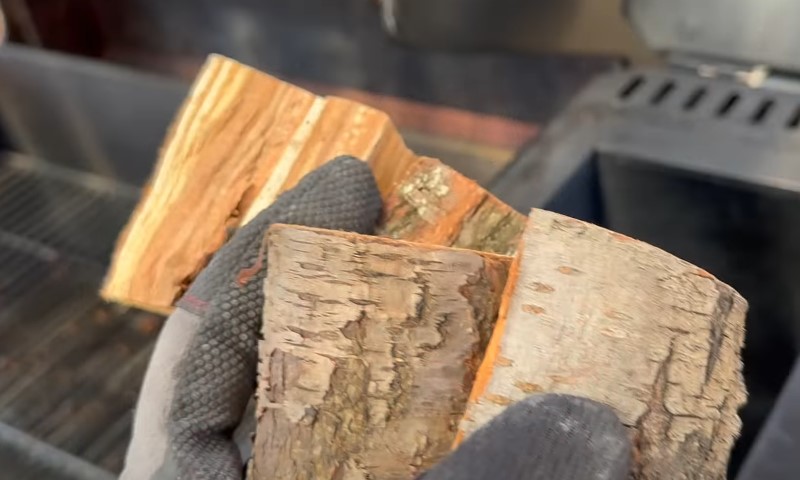
To make the math tangible, assume a 10-hour low-and-slow cook.
Pellet Grill Example
- Pellets: 1.5 lb per hour × 10 h = 15 lb. At 20 USD per 20 lb bag, pellets cost about 15 USD for the cook.
- Electricity: Startup ~300 to 600 W for 10 minutes, then ~40 W for 9 h 50 m. That’s roughly 0.45 to 0.55 kWh in total, often well under 0.10 USD in most markets.
Offset Smoker Example
- Wood: A well-built backyard offset may consume a modest stack of splits across 10 hours once the coal bed is established. Your cost depends on local wood pricing, but even at 300 USD per cord, individual cooks are inexpensive when buying by the cord or face cord. Owners commonly add a few small splits every 20 to 45 minutes for clean smoke.
Pros and Cons Summary
| Feature | Offset Smoker Pros | Offset Smoker Cons | Pellet Grill Pros | Pellet Grill Cons |
| Flavor | Deep, classic wood smoke flavor when run clean | Steeper learning curve | Set-and-forget temp control with tight consistency | Lighter smoke profile |
| Capacity | Large cooking surfaces for brisket, ribs, and mixed meats | Cheap, thin models can be frustrating | Versatile for smoking, roasting, baking | Searing performance varies |
| Power Needs | No electricity required | Weather affects fire management more | Wi-Fi and probe features add convenience | Requires electricity for auger and fan |
| Durability | Built to last if you buy heavy steel | Frequent tending | Good results for beginners and busy cooks | Must keep pellets dry |
Buying Tips From Trusted Testers
Here are some things you should pay attention to:
If You Go Pellet
Look for a sturdy controller, good temp range, ample hopper, and insulation for winter. Reputable testers like AmazingRibs and Consumer Reports regularly update model picks and price ranges.
Newer PID controllers and Wi-Fi help produce stable results. Start by browsing current ratings and year-round pricing data.
If You Go Offset
Save for thicker steel and solid welds. Reverse-flow designs can even out temperatures at the expense of a bit of airflow; traditional flow with good tuning plates also works well.
Avoid leaky budget tanks when possible. If your budget is tight, consider a respectable entry model and plan simple upgrades like better thermometers and gasket seals.
What a Typical Day Looks Like
A smoker or grill really shows its personality once you’re in the middle of a cook. Here’s a peek at what a normal day feels like with each style.
A Day With an Offset
- Start a coal bed with charcoal or small kindling.
- Stabilize the pit around 250°F with the stack mostly open, then adjust intake as needed.
- Add small, pre-warmed splits to maintain clear, thin smoke.
- Log cadence: Add a small split every 20 to 45 minutes, adjusting for weather, wood species, and pit mass.
- Finish and rest the meat.
A Day With a Pellet Grill
- Fill hopper with dry pellets.
- Set temperature on the controller or app.
- Insert probes for food and pit.
- Let it ride, checking from your phone if your unit supports it.
- Empty ash from time to time and keep pellets sealed between cooks.
FAQs
Pick an Offset Smoker If You:
- Love tending a live wood fire and want the deepest smoke character.
- Cook bigger weekend projects like brisket and pork shoulders.
- Don’t mind weather affecting your day and you can commit to learning fire management.
- Have the space and budget for a heavier pit that will hold heat well.
Pick a Pellet Grill If You:
- Want reliable, repeatable results with little babysitting.
- Cook throughout the week for family meals, not only weekend all-day smokes.
- Prefer lighter smoke and appreciate modern features like Wi-Fi and probes.
- Have access to power and plan to keep pellets dry and stocked.
Bottom Line
If you want the craft and flavor of a live wood fire and you enjoy the process, an offset smoker will reward you for years. If you want convenience, consistency, and flexibility for both weekend smokes and weeknight roasts, a pellet grill is a smart buy.
Both tools can produce great barbecue. Your choice depends on how you like to cook, how much time you want to spend tending the fire, and what kind of flavor speaks to you.
